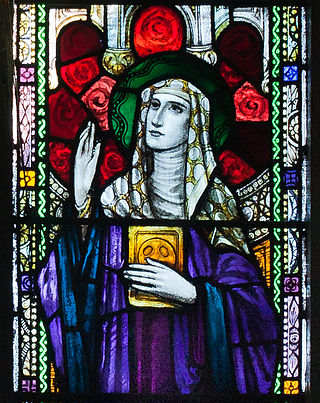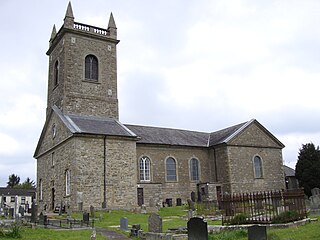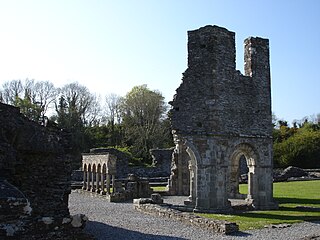
Saint Brigid of Kildare or Brigid of Ireland is the patroness saint of Ireland, and one of its three national saints along with Patrick and Columba. According to medieval Irish hagiographies, she was an abbess who founded the important abbey of Kildare, as well as several other convents of nuns. There are few historical facts about her, and her hagiographies are mainly anecdotes and miracle tales, some of which are rooted in pagan folklore. They say Brigid was the daughter of a chieftain and a slave woman, and was raised in a druid's household before becoming a consecrated virgin. She is patroness of many things, including poetry, learning, healing, protection, blacksmithing, livestock and dairy production. In her honour, a perpetual fire was kept burning at Kildare for centuries.

Christian monasticism is the devotional practice of Christians who live ascetic and typically cloistered lives that are dedicated to Christian worship. It began to develop early in the history of the Christian Church, modeled upon scriptural examples and ideals, including those in the Old Testament, but was not mandated as an institution in the scriptures. It has come to be regulated by religious rules and, in modern times, the Canon law of the respective Christian denominations that have forms of monastic living. Those living the monastic life are known by the generic terms monks (men) and nuns (women). The word monk originated from the Greek μοναχός, itself from μόνος meaning 'alone'.

Hilda of Whitby was a Christian saint and the founding abbess of the monastery at Whitby, which was chosen as the venue for the Synod of Whitby in 664. An important figure in the Christianisation of Anglo-Saxon England, she was abbess at several monasteries and recognised for the wisdom that drew kings to her for advice.

Íte ingen Chinn Fhalad, also known as Íde, Ita, Ida or Ides, was an early Irish nun and patron saint of Killeedy. She was known as the "foster mother of the saints of Erin". The name "Ita" was conferred on her because of her saintly qualities. Her feast day is 15 January.

Clogher is a village and civil parish in the border area of south County Tyrone, Northern Ireland. It lies on the River Blackwater, 5.8 miles from the border crossing to County Monaghan. It stands on the townlands of Clogher Demesne and Clogher Tenements. The 2011 Census recorded a population of 717. The civil parish of Clogher covers areas of County Fermanagh as well as County Tyrone.
Saint Enda of Aran is an Irish saint. His feast day is 21 March.

Mellifont Abbey, was a Cistercian abbey located close to Drogheda in County Louth, Ireland. It was the first abbey of the order to be built in Ireland. In 1152, it hosted the Synod of Kells-Mellifont. After its dissolution in 1539, the abbey became a private manor house. This saw the signing of the Treaty of Mellifont in 1603 and served as William of Orange's headquarters in 1690 during the Battle of the Boyne.

Rafqa Pietra Chobok, also known as Saint Rafka and Saint Rebecca, was a Lebanese Maronite nun who was canonized by Pope John Paul II on June 10, 2001.

Saint Colman mac Duagh was born at Corker, Kiltartan, County Galway, Ireland, the son of the Irish chieftain Duac. He initially lived as a recluse, living in prayer and prolonged fastings, first on Inismore, then in a cave at the Burren in County Clare. With his relative, King Guaire Aidne mac Colmáin of Connacht he founded the monastery of Kilmacduagh,, and governed it as abbot-bishop.

December 31 - Eastern Orthodox liturgical calendar - January 2
Killeany was an Irish monastery.

Saint Moninne or Modwenna of Killeavy was one of Ireland's early female saints. After instruction in the religious life, she founded a community, initially consisting of eight virgins and a widow with a baby, at Slieve Gullion, in what became County Armagh. They lived an eremitical life, based on that of Elijah and Saint John the Baptist. Moninne died in 517. Her feast day is 6 July.
There is archaeological evidence of insular monasticism as early as the mid 5th century, influenced by establishments in Gaul such as the monastery of Martin of Tours at Marmoutier, the abbey established by Honoratus at Lérins; and that of Germanus at Auxerre. Many Irish monks studied at Candida Casa near Whithorn in what is now Galloway in Scotland.

Tigernach mac Coirpri (d. 549) was an early Irish saint, patron saint of Clones (Co. Monaghan) in the province of Ulster.
Nem Moccu Birn was Abbot of Aran. His feast day is 14 June.

Saint Demiana and the 40 Virgins was a Coptic martyr of the early fourth century.

March 20 – Eastern Orthodox liturgical calendar – March 22
Saint Brecan was an Irish saint active in the 5th century AD. There are legends concerning Brecan from Clare and Aran, and wells and churches are dedicated to him in various places in Ireland. His main monument is the Tempull Breccain complex on Inishmore in the Aran Islands.

Saint Silaus of Lucca was an Irish bishop who died in Lucca, Tuscany, while returning from a pilgrimage. His feast day is 17 May.













